The sixth and final Apollo Moon landing mission began with the Dec. 7, 1972, launch of Apollo 17. In the first night launch of the American human spaceflight program, the giant Saturn V rocket lifted off from Launch Pad 39A and lit up the sky at NASA’s Kennedy Space Center (KSC) in Florida. Commander Eugene A. Cernan, Command Module Pilot Ronald E. Evans, and Lunar Module Pilot Harrison H. “Jack” Schmitt, the first trained geologist to travel to the Moon, rode the pillar of flame into a parking orbit around the Earth. The rocket’s third stage reignited to send them on their way to the Moon. Following an uneventful three-day coast to the Moon, Cernan, Evans, and Schmitt arrived in lunar orbit on Dec. 10 to prepare for the landing at the Taurus-Littrow site and to conduct scientific observations from lunar orbit.
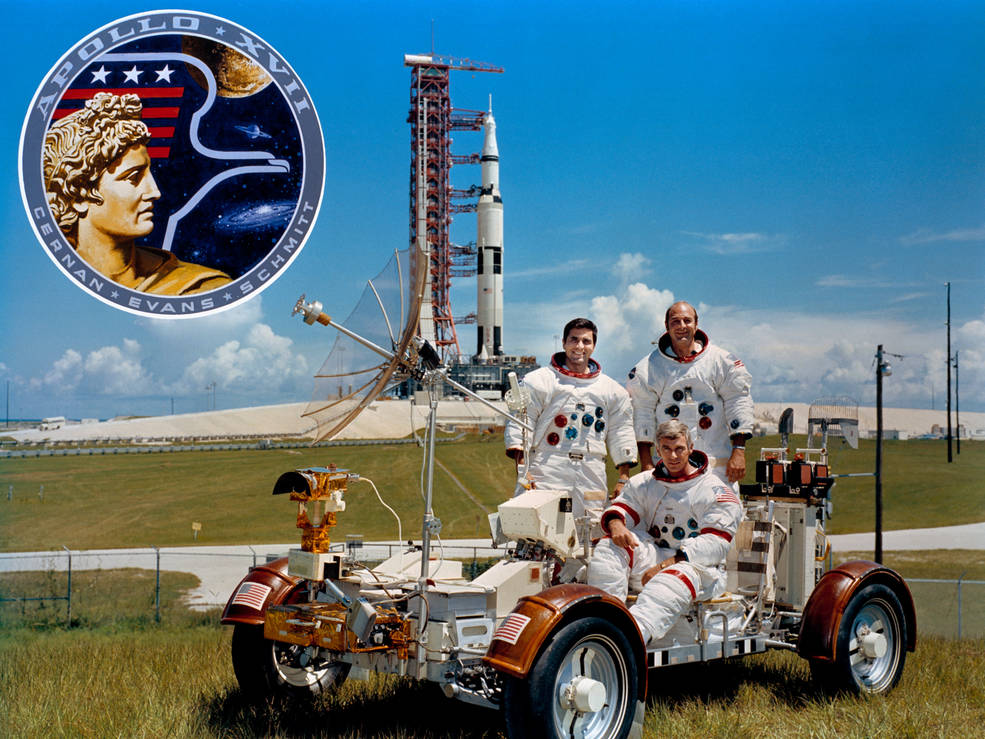
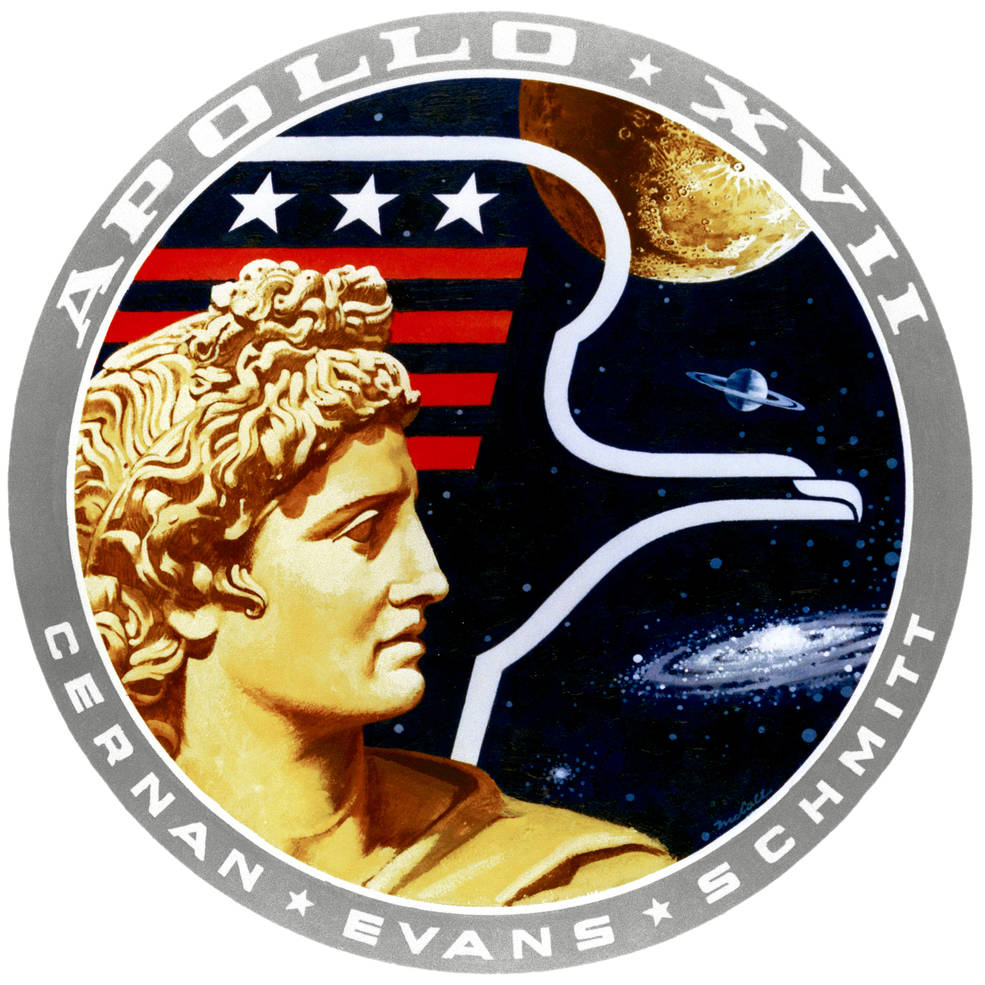
Left: The Apollo 17 crew of Harrison H. “Jack” Schmitt, left, Ronald E. Evans, and Eugene A. Cernan, seated, pose in a Lunar Roving Vehicle in front of their Saturn V rocket at NASA’s Kennedy Space Center in Florida. Right: The Apollo 17 crew patch.
Engineers in Firing Room 1 of KSC’s Launch Control Center (LCC) monitored all aspects of the countdown, begun on Dec. 5, including the final fueling of the Saturn V rocket. Cernan, Evans, and Schmitt ate their traditional prelaunch breakfast before putting on their spacesuits and taking the Astrovan to Launch Pad 39A, where they boarded their spacecraft, the Command Module (CM) America. Cernan took the left-hand seat, Schmitt the right, and finally Evans settled in the middle. Thousands of spectators assembled along the beaches near KSC to view the launch. Vice President Spiro T. Agnew arrived in the firing room’s viewing gallery to watch the launch with senior NASA managers. The terminal countdown for Apollo 17’s launch proceeded without any significant issues until 30 seconds before the planned launch time of 9:53 p.m. EST on Dec. 6.
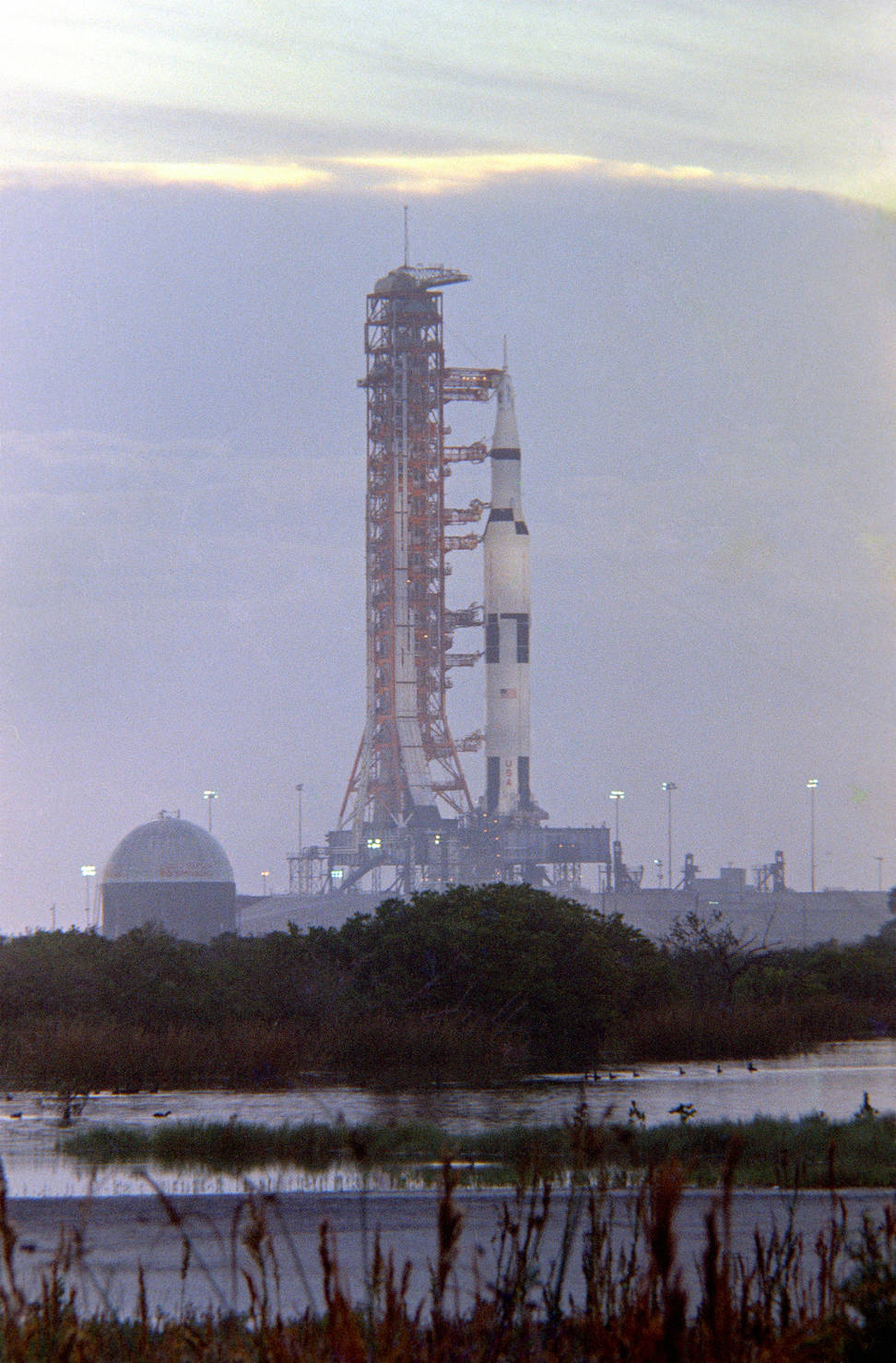
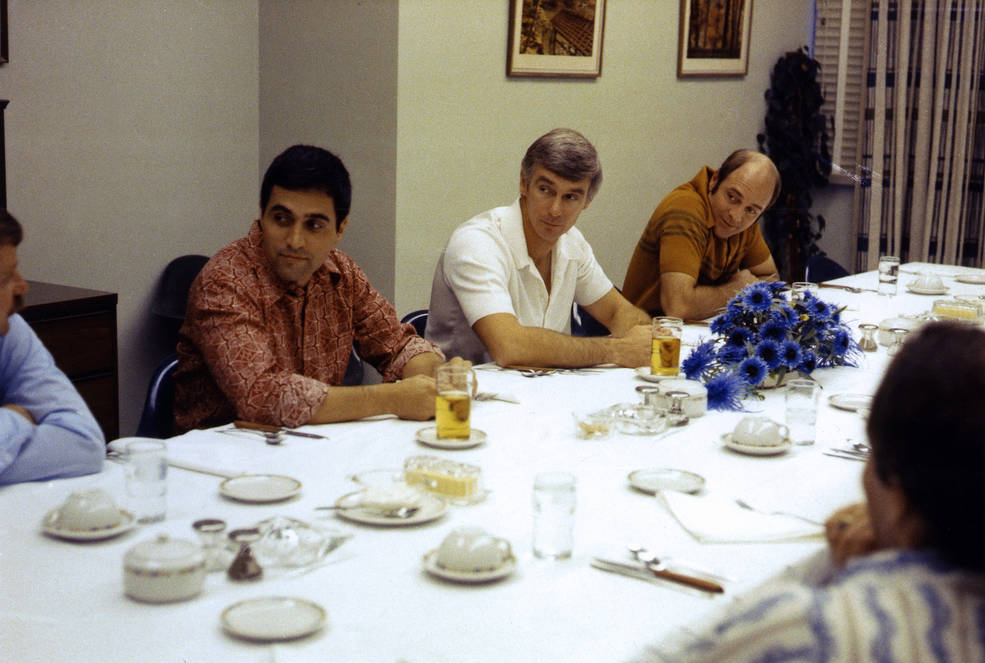
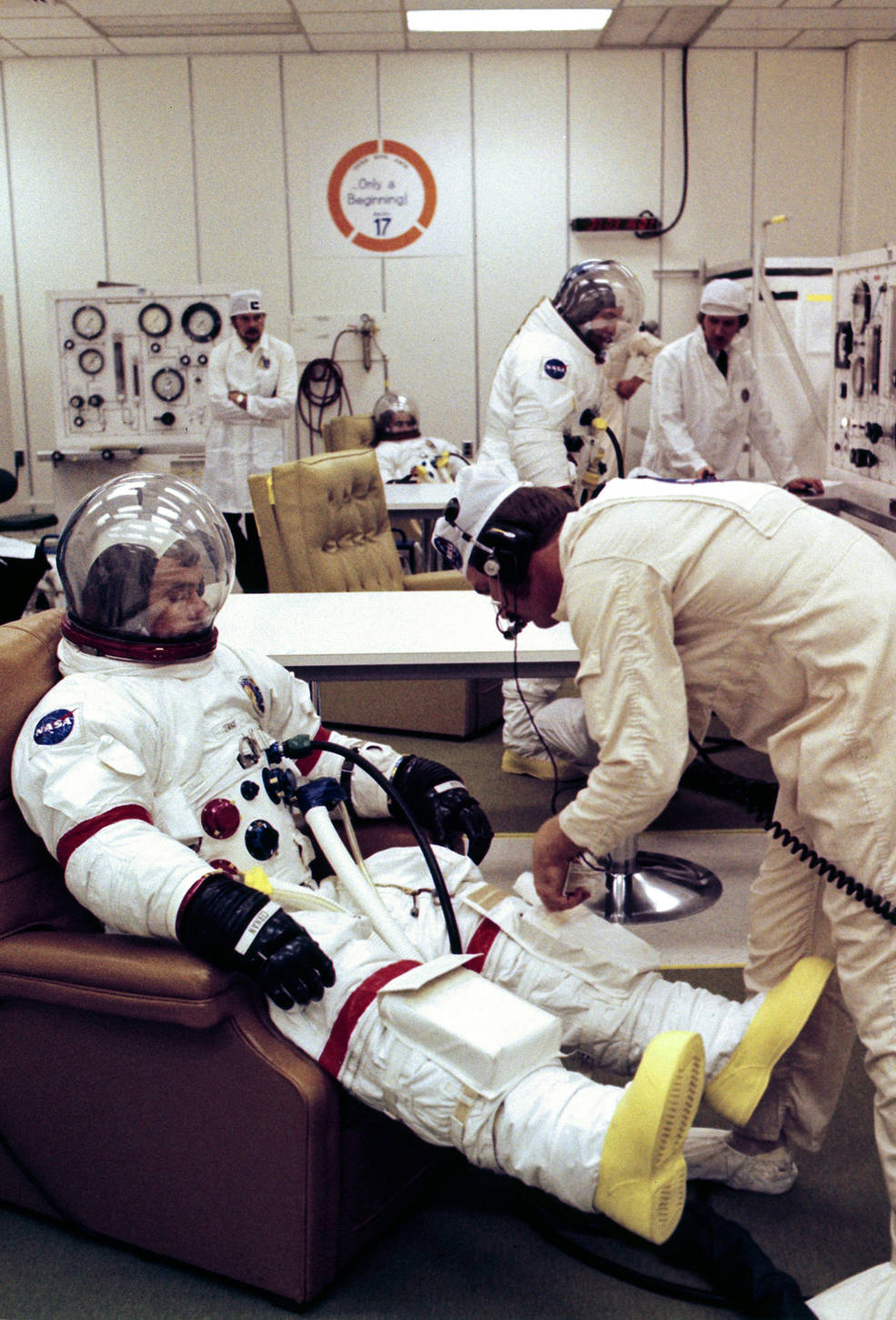
Left: The Saturn V on the morning of launch. Middle: At the traditional prelaunch breakfast, Apollo 17 astronauts Harrison H. “Jack” Schmitt, left, Eugene A. Cernan, and Ronald E. Evans are joined by backup and support astronauts and managers. Right: Apollo 17 astronauts Cernan, left, Evans, and Schmitt suit up prior to their launch.
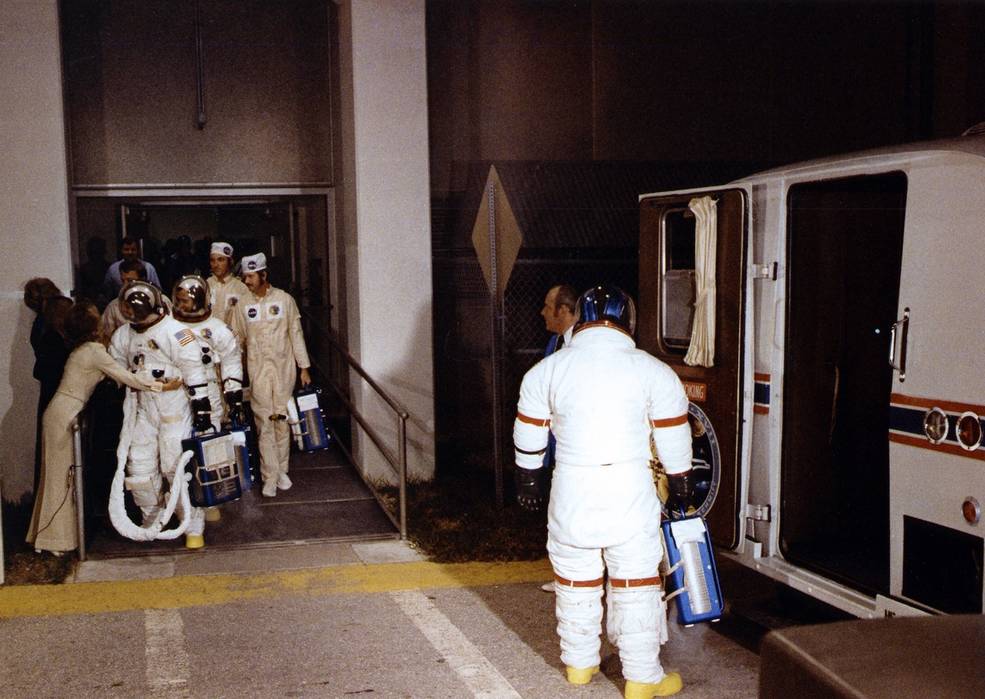
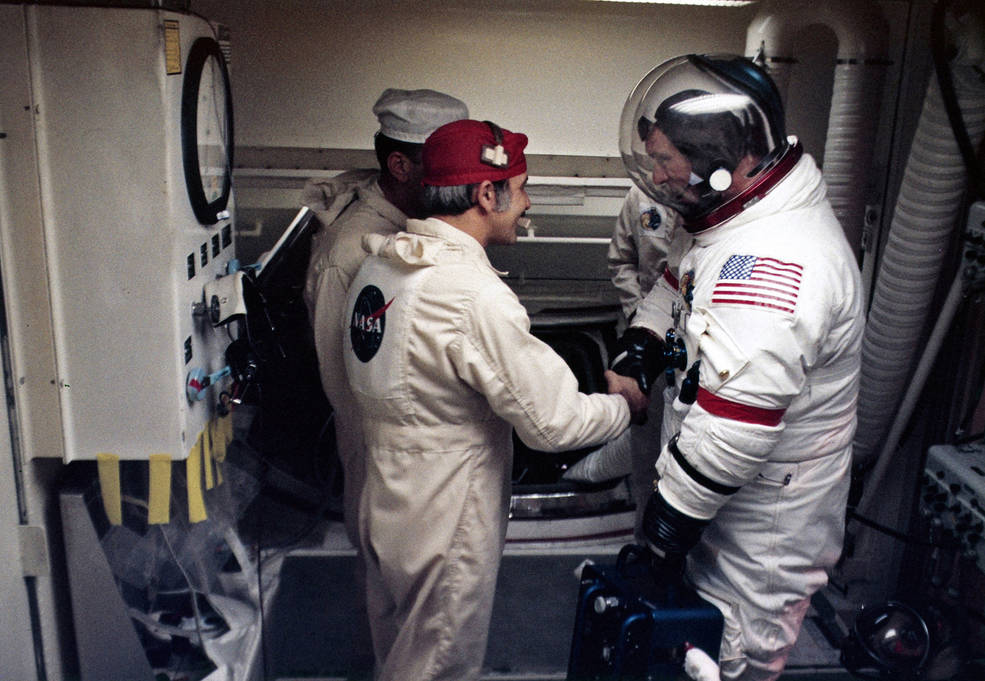
Left: Apollo 17 astronauts Eugene A. Cernan, right, awaits fellow crew members Ronald E. Evans, left, and Harrison H. “Jack” Schmitt as they say goodbye to their families before boarding the Astrovan for the ride out to Launch Pad 39A. Right: In the White Room at Launch Pad 39A, the closeout team greet Cernan before helping him to board the Command Module America.
At that moment, the Ground Launch Sequencer computer that controlled the countdown called a halt when it detected that the computer had failed to send a command two minutes earlier to pressurize the liquid oxygen tank in the rocket’s S-IVB third stage. Although an engineer had caught the error and sent the command in the computer’s place and the tank had pressurized as expected, the software only recognized the failure to send the signal. After identifying the problem, ground controllers recycled the countdown to T-22 minutes, and then held it again at T-8 minutes as they continued to resolve the issue. The count eventually resumed and reached T-0, 2 hours and 40 minutes late.
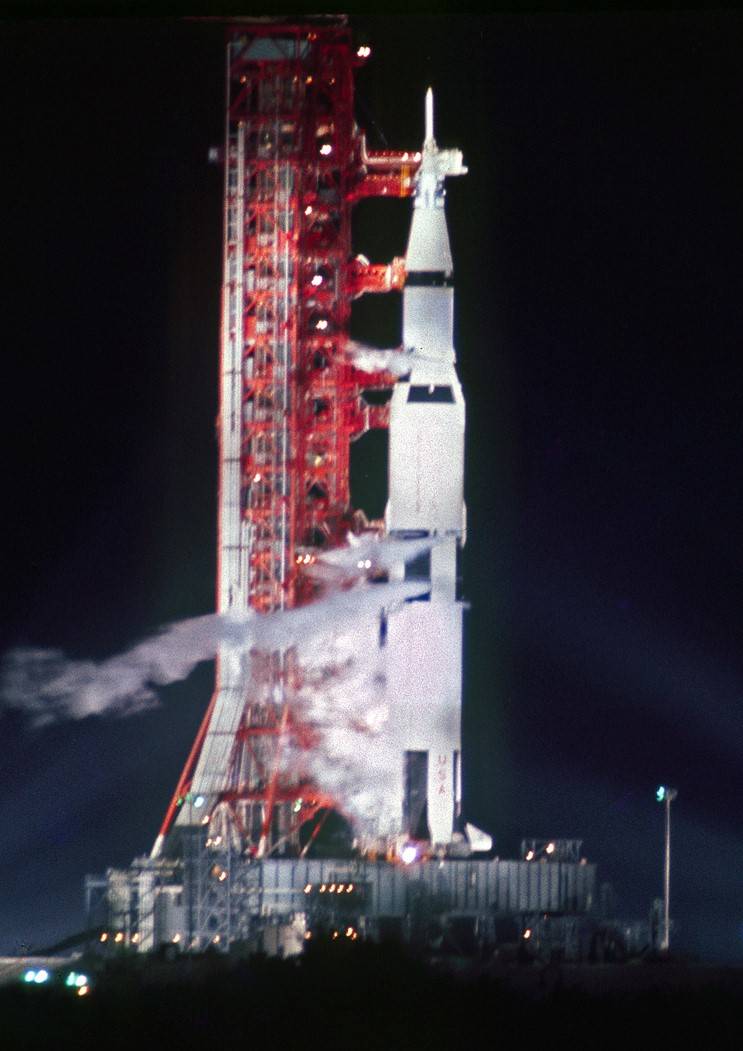
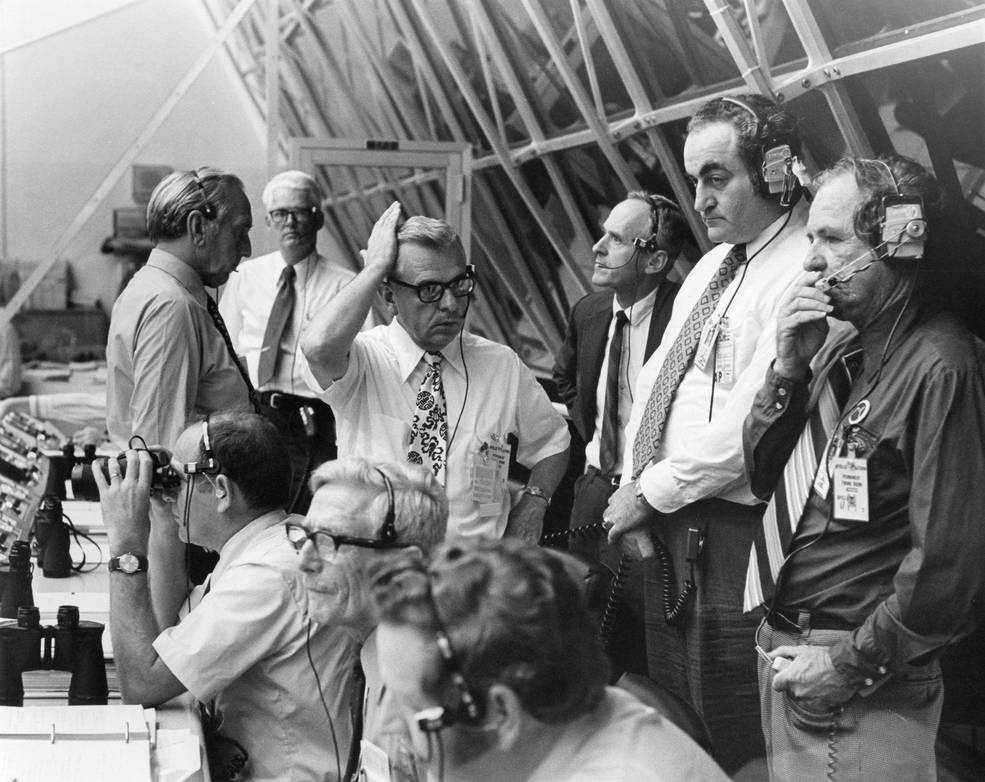
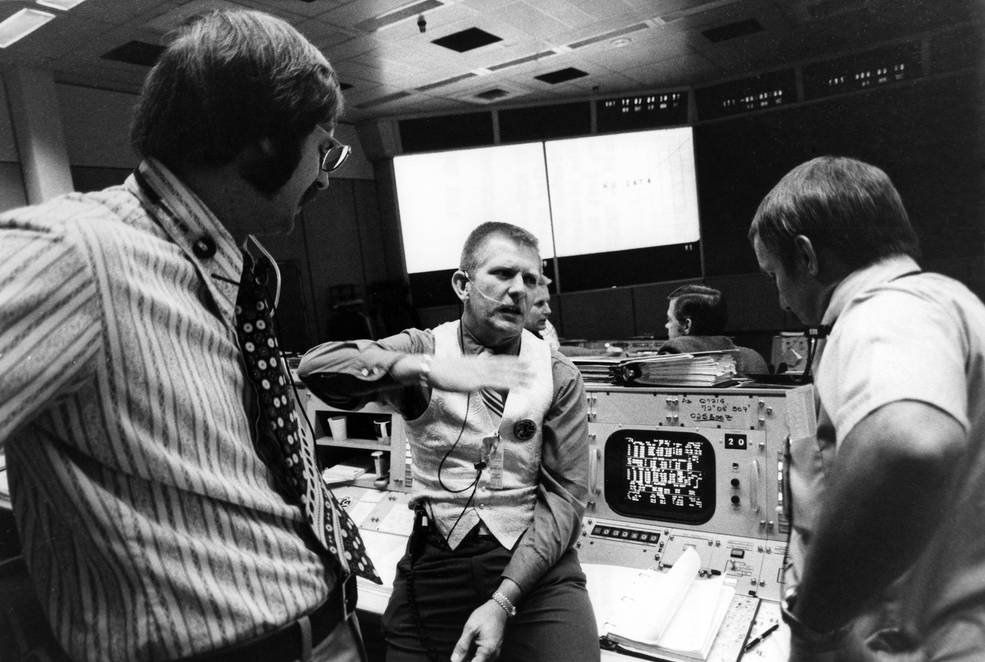
Left: The Apollo 17 Saturn V launch vehicle during the countdown hold. Middle: Managers in the Launch Control Center at NASA’s Kennedy Space Center in Florida during the countdown hold. Right: Flight Directors Neil A. Hutchinson, left, Eugene F. Kranz, and Gerald D. Griffin during the countdown hold, in the Mission Control Center at the Manned Spacecraft Center, now NASA’s Johnson Space Center in Houston.
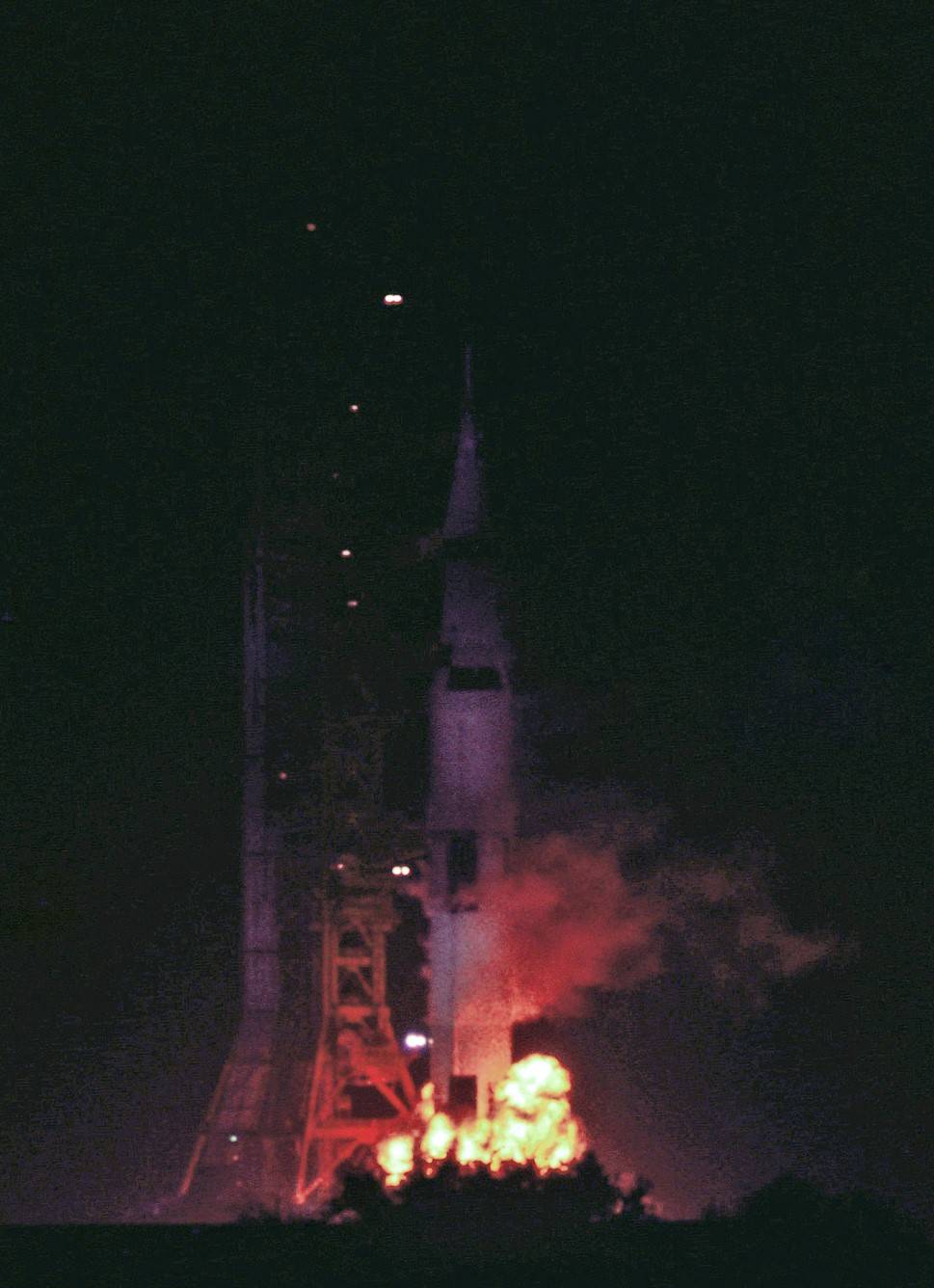
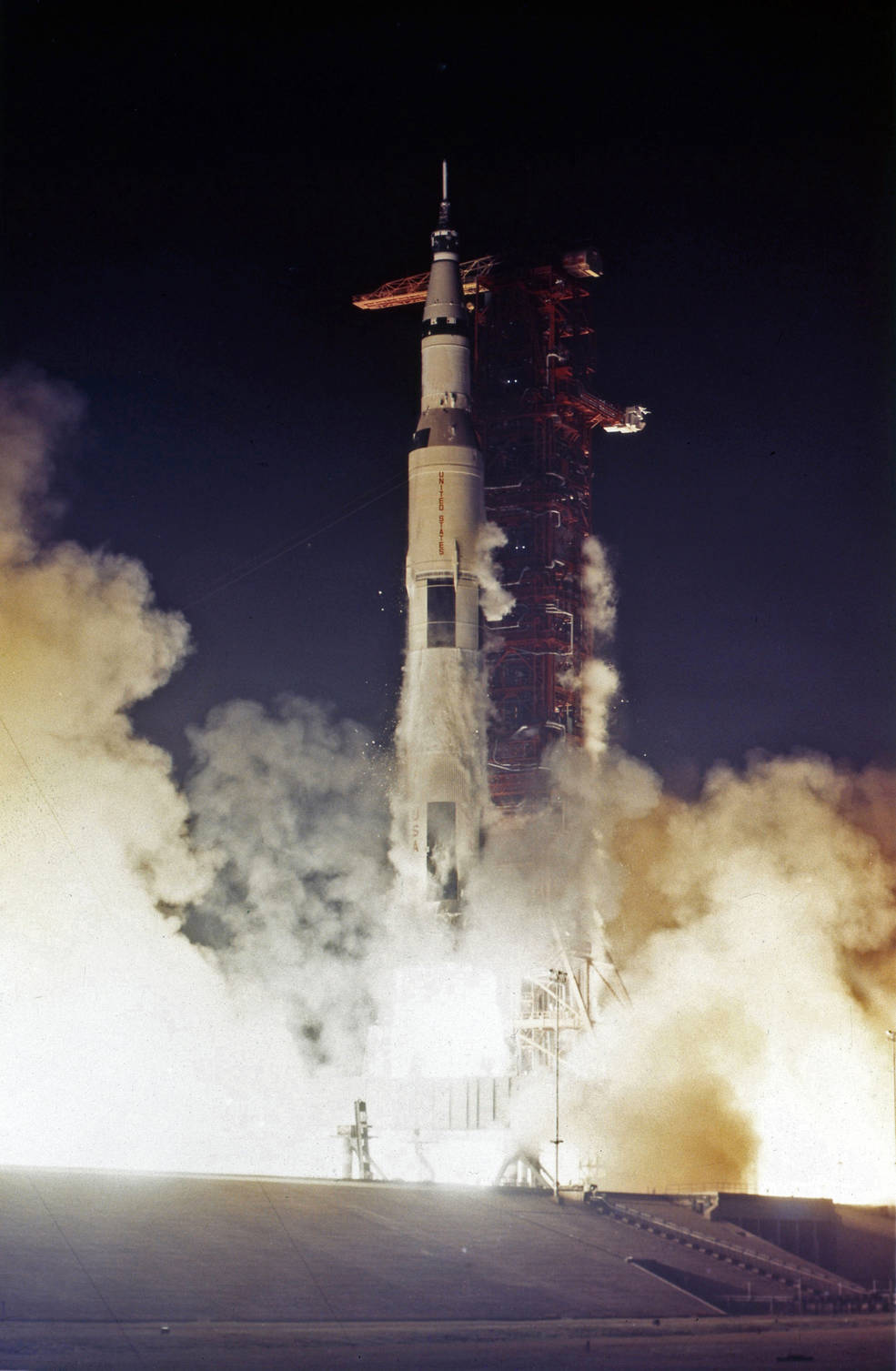
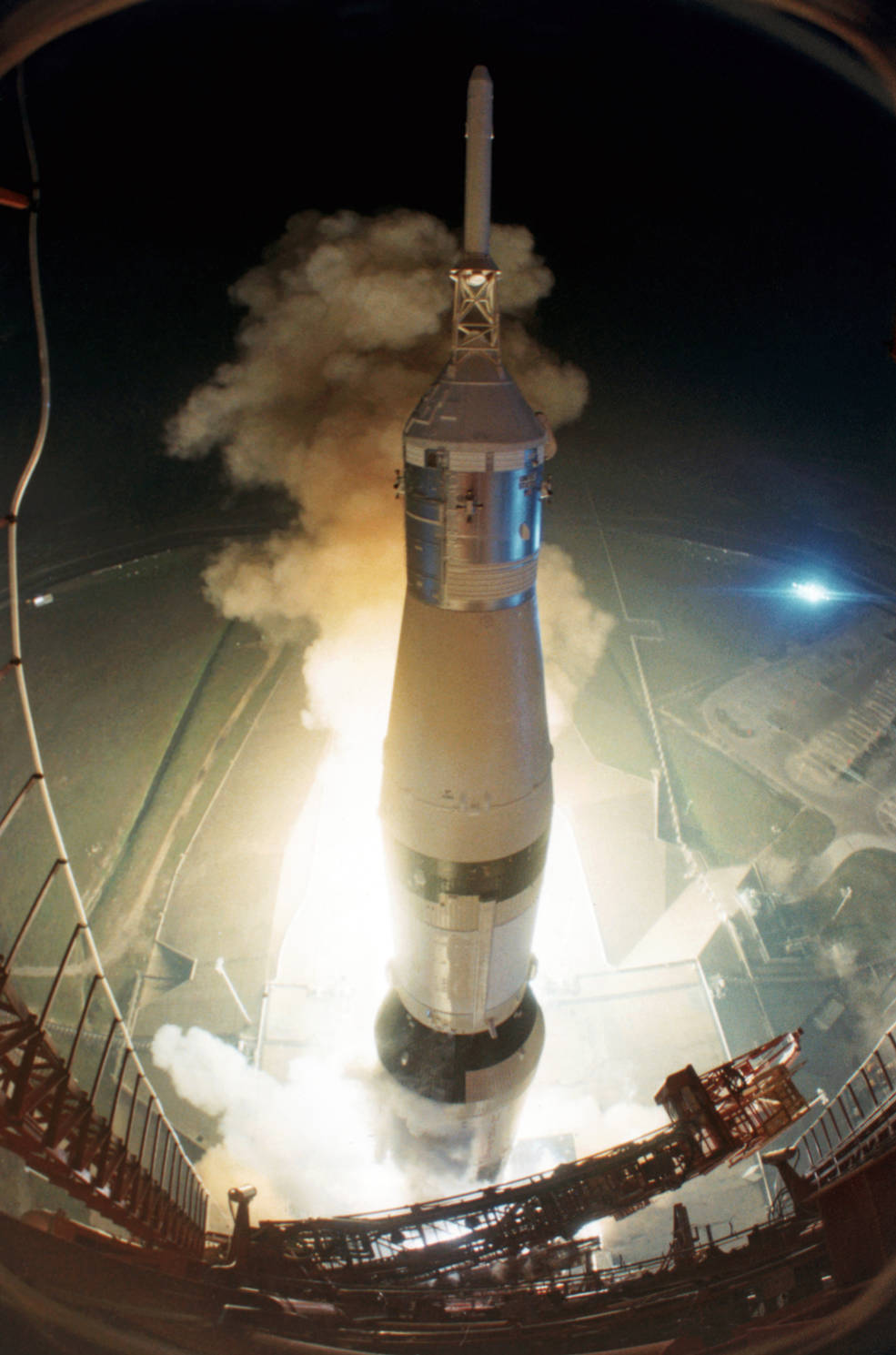
Left: The Apollo 17 Saturn V rocket at the moment of ignition. Middle: Liftoff of Apollo 17. Right: View of liftoff from the Launch Umbilical Tower.
At 33 minutes past midnight EST on Dec. 7, the five F-1 first stage engines ignited, essentially turning night into day at KSC. The Saturn V rocket rose slowly from the pad, clearing the launch umbilical tower a few seconds later. At this point, control of the flight shifted from KSC’s LCC to the Mission Control Center (MCC) at the Manned Spacecraft Center, now NASA’s Johnson Space Center in Houston, where Flight Director Eugene F. Kranz led his White Team of controllers, including capsule communicator (capcom) astronaut Robert F. Overmyer.
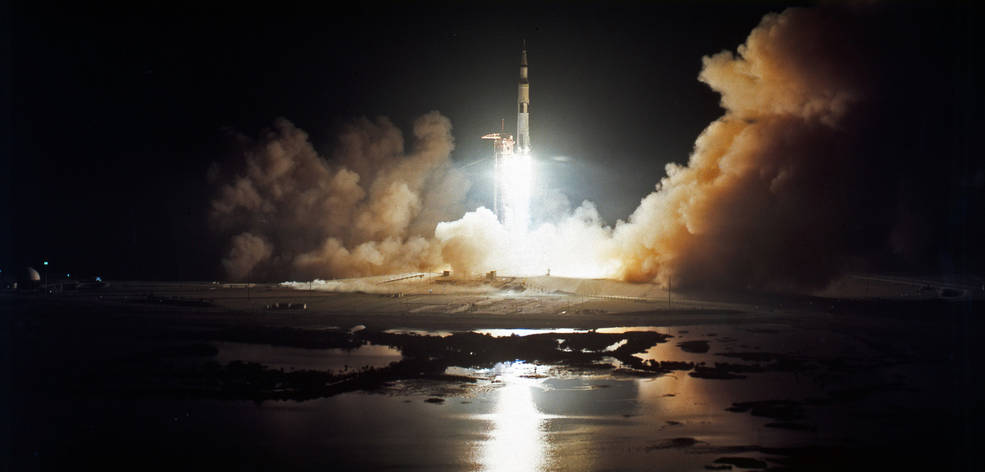
Apollo 17 lights up the night sky!
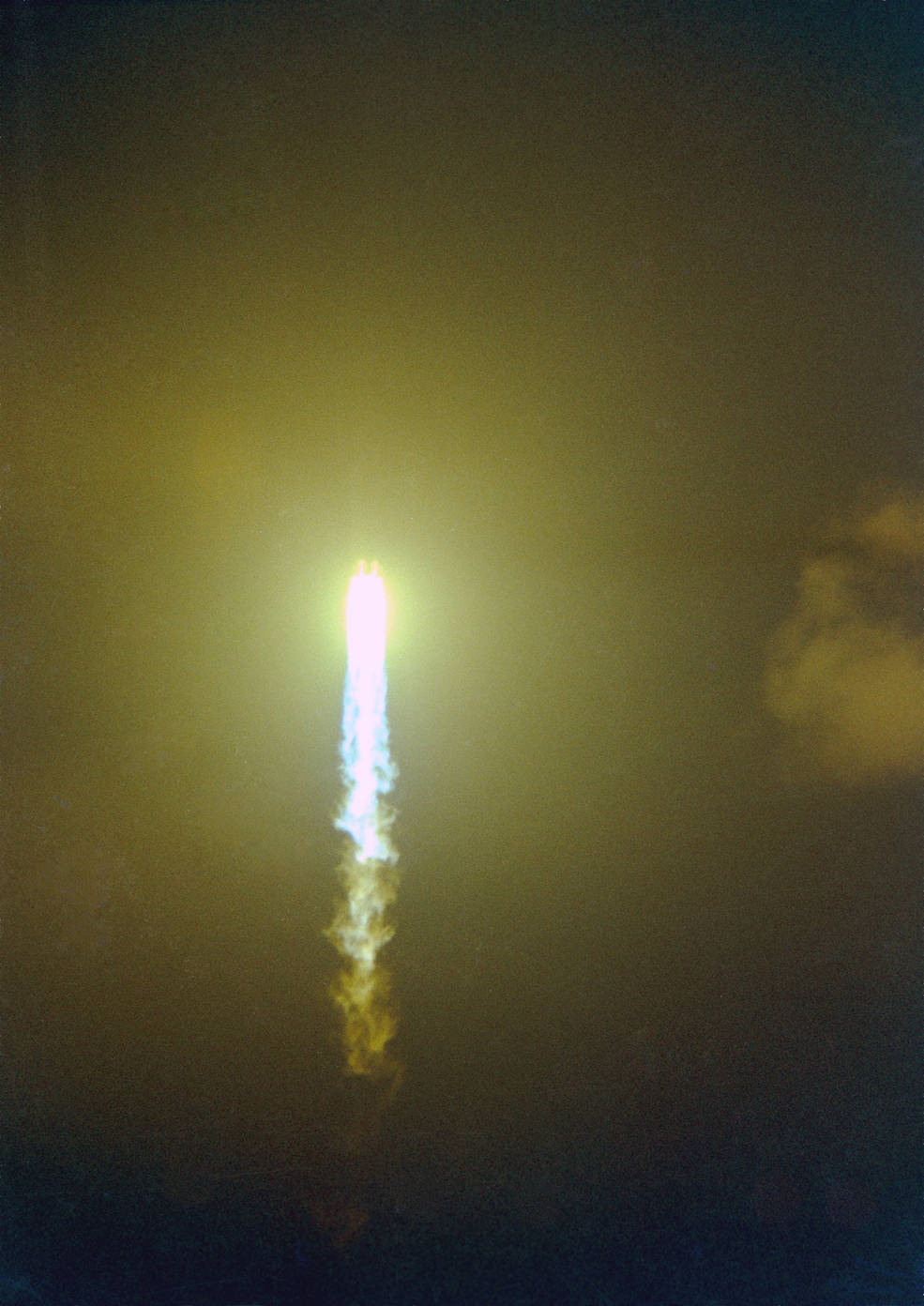
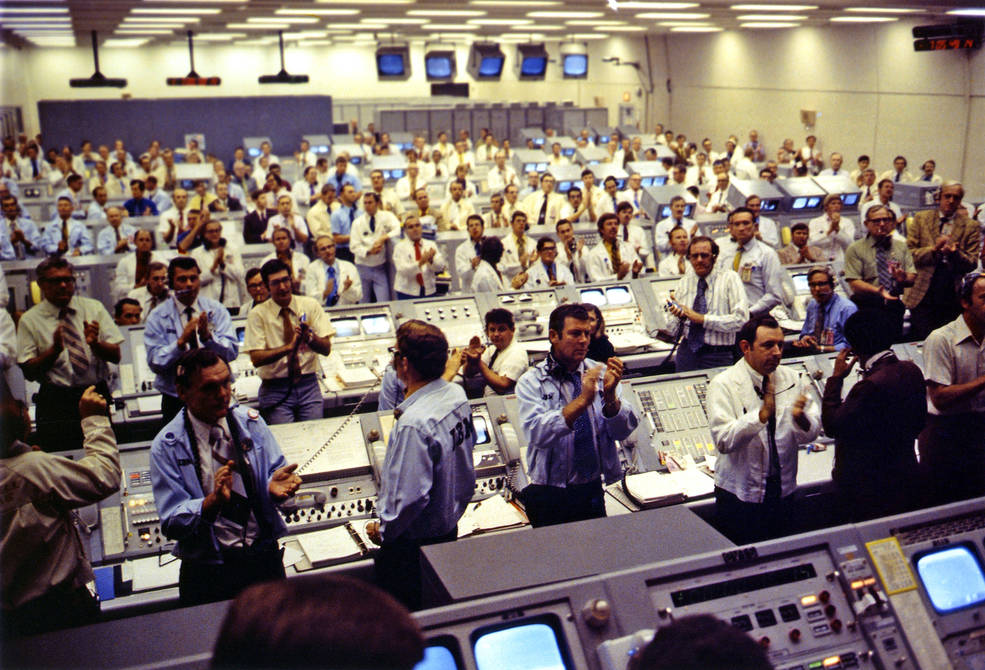
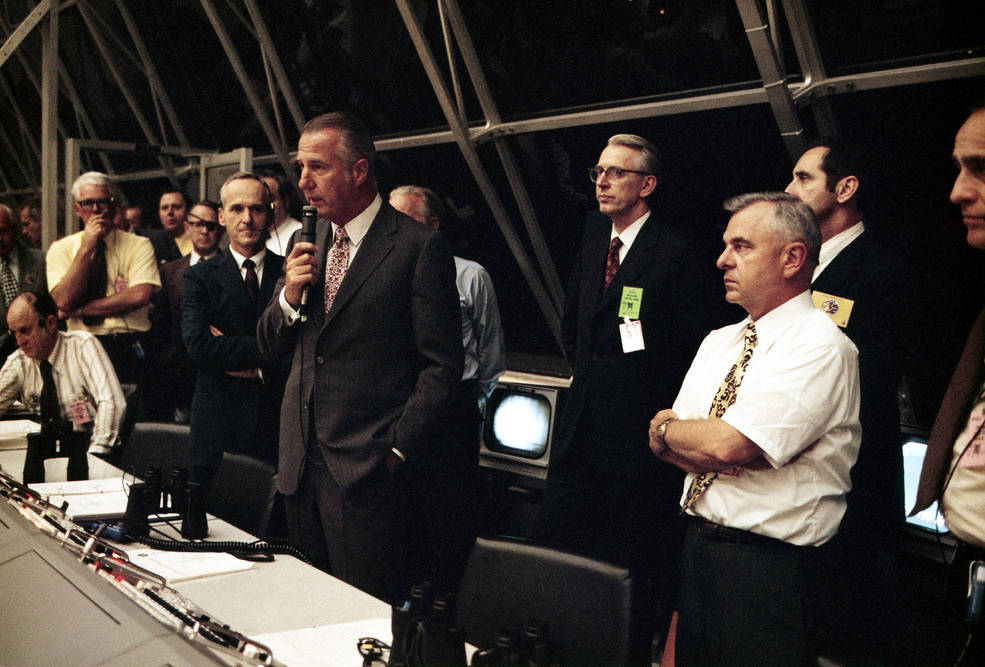
Left: Apollo 17 continues its ascent. Middle: Controllers in Firing Room 1 of the Launch Control Center (LCC) cheer as Apollo 17 continues its climb into space. Right: NASA managers listen as Vice President Spiro T. Agnew congratulates the LCC team.
After burning for 2 minutes and 41 seconds and lifting the rocket to an altitude of 40 miles, the S-IC first stage engines shut off and the stage jettisoned. The S-II second stage ignited and continued to power the ascent until 9 minutes 20 seconds, taking the spacecraft nearly to orbit, at which time it too was jettisoned, and the S-IVB third stage took over. It burned for a little more than two and a half minutes to place Apollo 17 into a circular 104-mile-high parking orbit around the Earth. The astronauts were now weightless, and Cernan reported enthusiastically, “… that was quite a booster ride!” For the next three hours, Apollo 17, still attached to the Saturn V’s third stage, orbited the Earth. Cernan, Evans, and Schmitt removed their helmets and gloves but for now kept their spacesuits on. Together with Mission Control, they determined that all onboard systems were working nominally, and that they could proceed with Trans-Lunar Injection (TLI), the second burn of the Saturn V’s S-IVB third stage to send them out of Earth orbit and toward the Moon. Three hours and 12 minutes after liftoff, the engine ignited and fired for 5 minutes and 52 seconds, increasing Apollo 17’s velocity to 24,242 miles per hour to begin the three-day coast to the Moon. The burn took place as the spacecraft passed into an orbital sunrise.
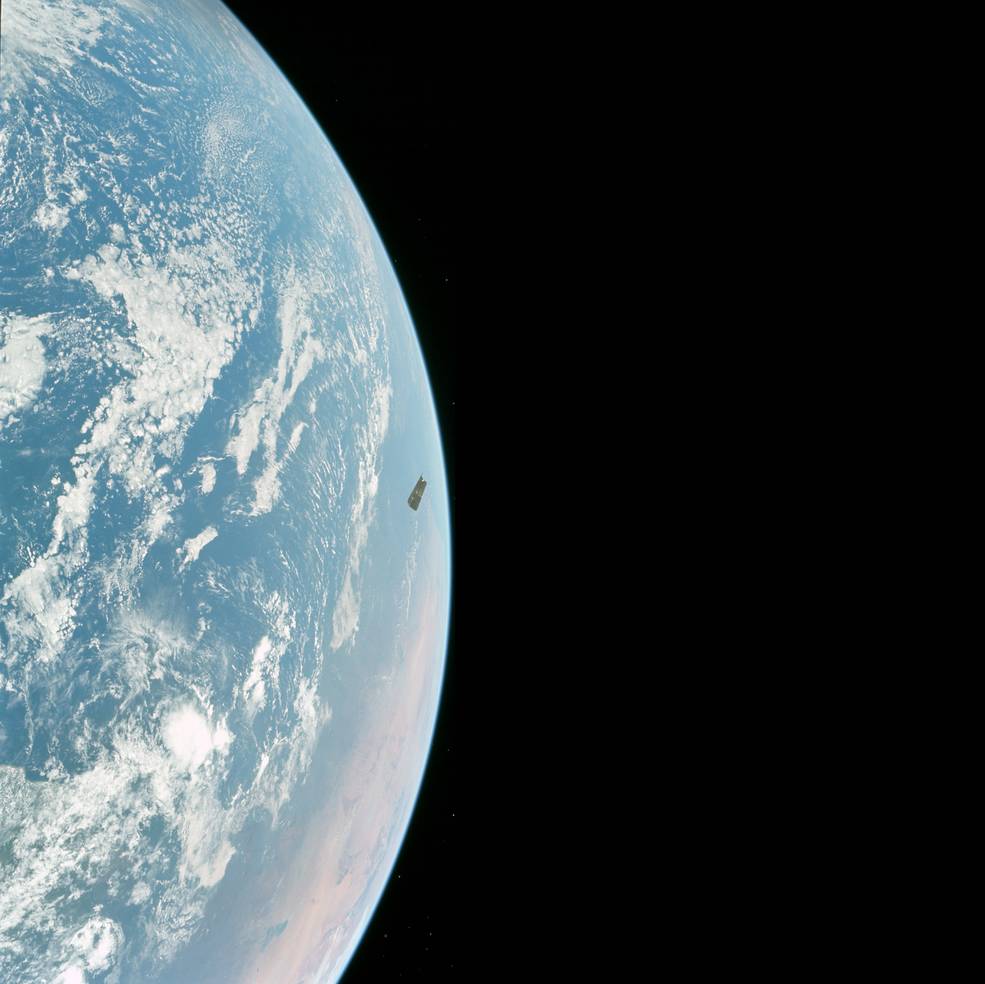
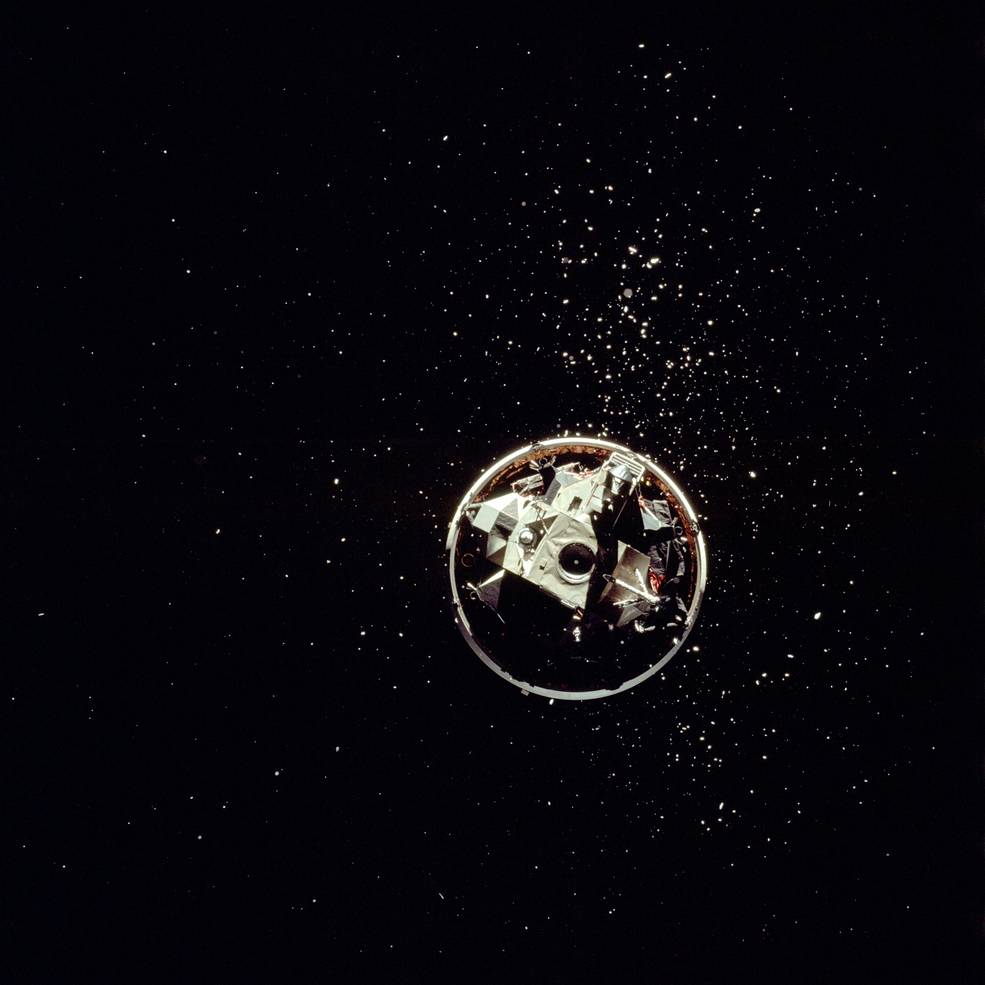
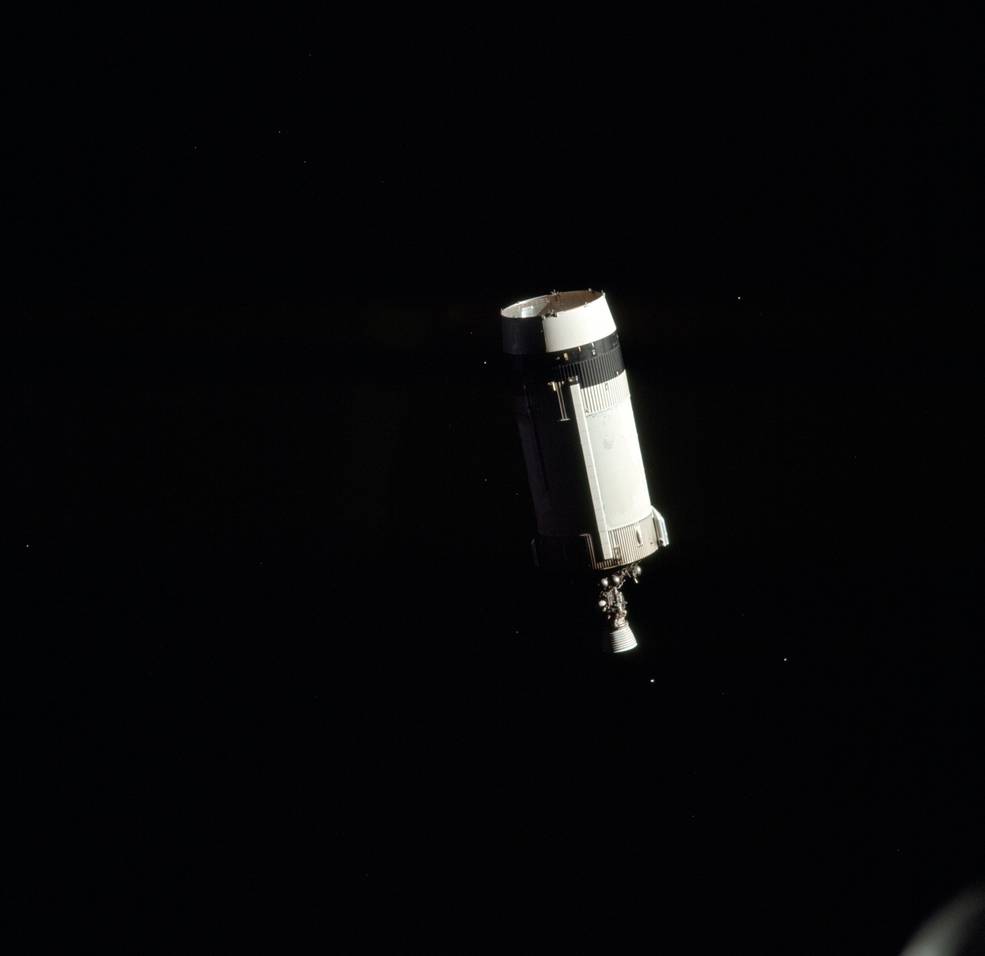
Left: One of the Spacecraft Lunar Module (LM) Adapter panels flies away following separation of the Command and Service Module from the Saturn V’s S-IVB stage. Middle: A cloud of ice and paint particles surround the LM Challenger, still attached to the S-IVB during the Transposition and Docking maneuver. Right: The spent S-IVB stage.
Thirty minutes after the completion of the TLI burn, the astronauts separated the Command and Service Modules (CSM) from the third stage. The four Spacecraft LM Adapter panels jettisoned to reveal the LM Challenger still attached to the S-IVB. Evans maneuvered the CSM a short distance away from the S-IVB, turned the spacecraft around and then began a slow approach to the LM, successfully completing the docking. With an indication that at least one of the 12 latches didn’t activate properly, the astronauts pressurized the tunnel between the two spacecraft, removed the hatch on the CM side, and, realizing that three latches hadn’t activated, manually set them. They replaced the hatch and then separated the LM, now docked to the front of the CSM, from the S-IVB. They had already reached a distance of 15,000 miles from the Earth. As the astronauts watched, the S-IVB stage maneuvered into an attitude to fire its engine to send it on a course to crash on the Moon in three days to trigger the seismometers left on the surface by the Apollo 12, 14, 15, and 16 crews.

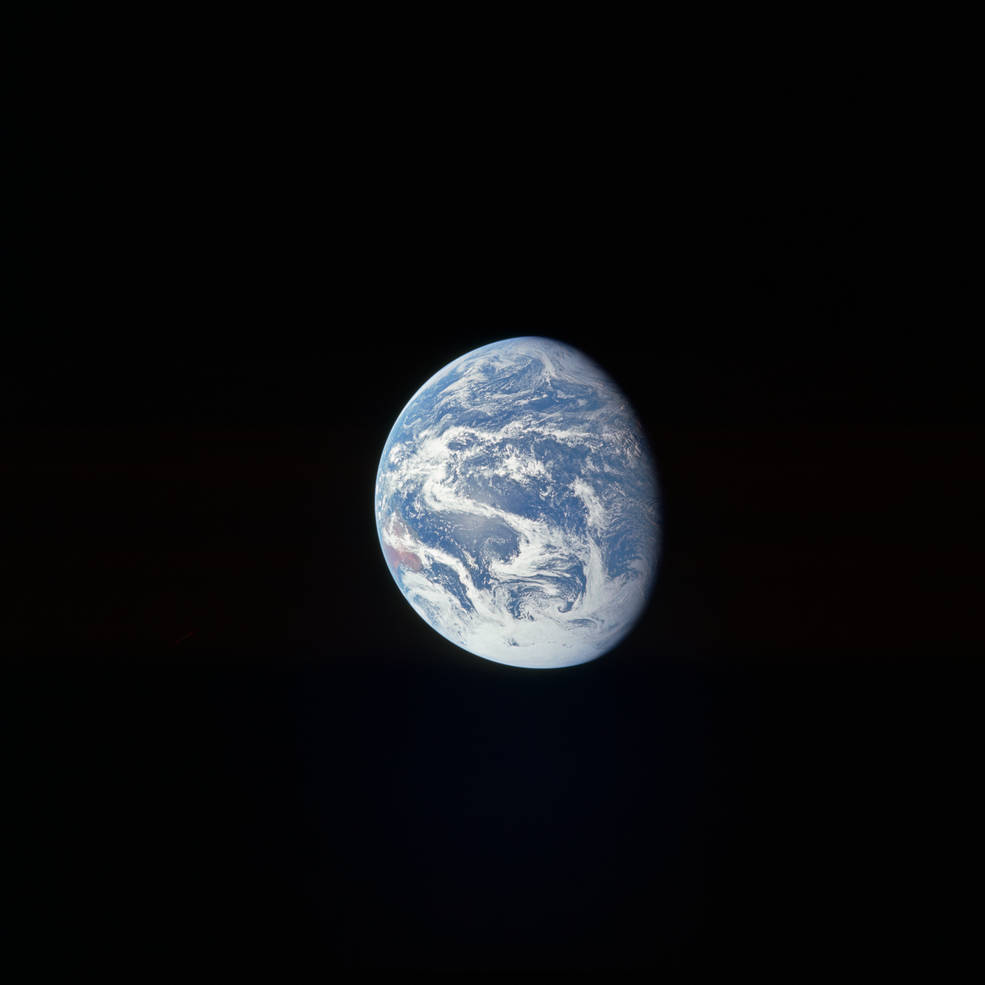
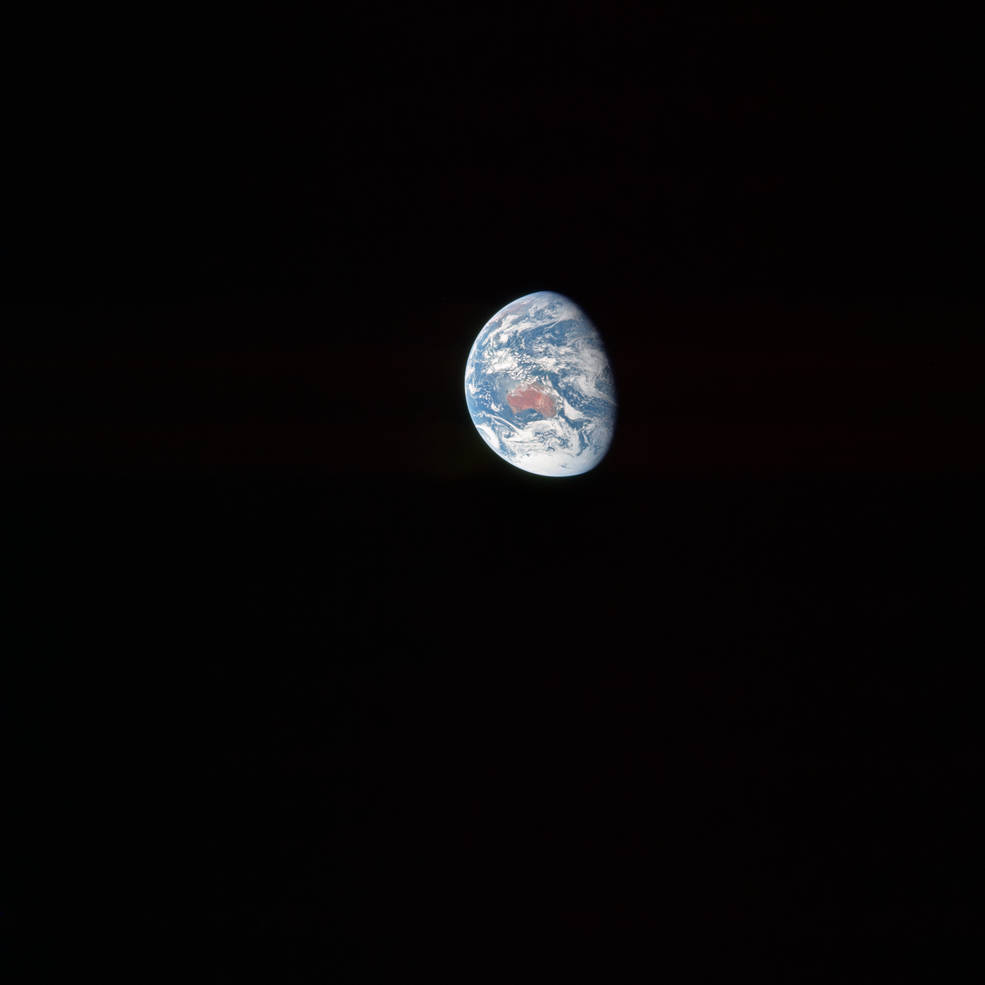
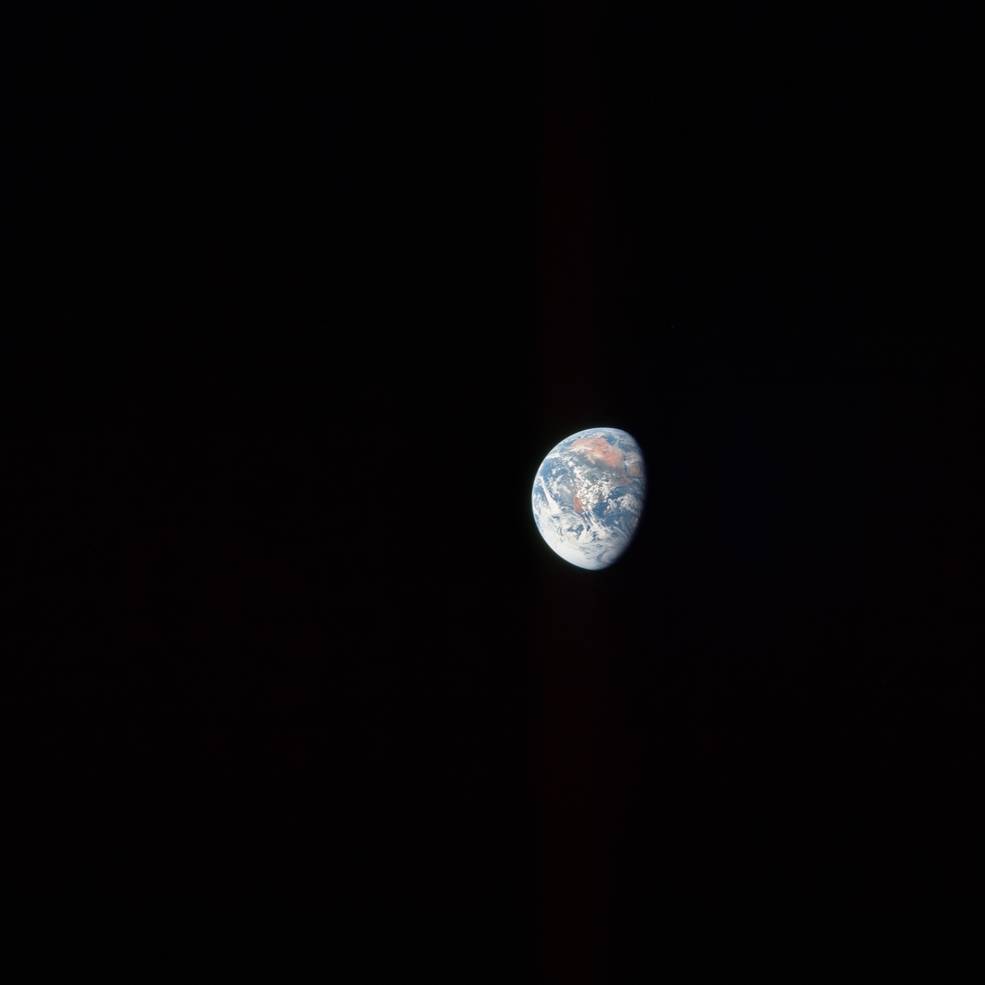
The Apollo 17 astronauts’ photographs of the receding Earth from 18,300 miles, left, from the Blue Marble series, 103,000 miles, 180,000 miles, and 236,000 miles.
Shortly after the S-IVB departed, Evans took four photographs showing the full disk of the Earth, with Africa in the center and Antarctica at the bottom. One of this series, known as the Blue Marble photographs, has the reputation as the most reproduced photograph of all time. Cernan, Evans, and Schmitt finally removed the spacesuits they had been wearing since several hours before launch and ate their first meal since the prelaunch breakfast.
In Mission Control, Kranz’s White Team handed over to Flight Director M.P. “Pete” Frank and his Orange Team of controllers, with astronaut Robert A. Parker replacing Overmyer as capcom. The flight control team decided that because of the accuracy of the TLI burn, the astronauts would not need to perform the planned first midcourse correction. The astronauts placed their spacecraft into the passive thermal control (PTC) or barbecue mode, in which the vehicle slowly rotated along its longitudinal axis three times per hour to evenly distribute temperatures. They then settled down for their first night’s sleep in space, already more than 50,000 miles from Earth.
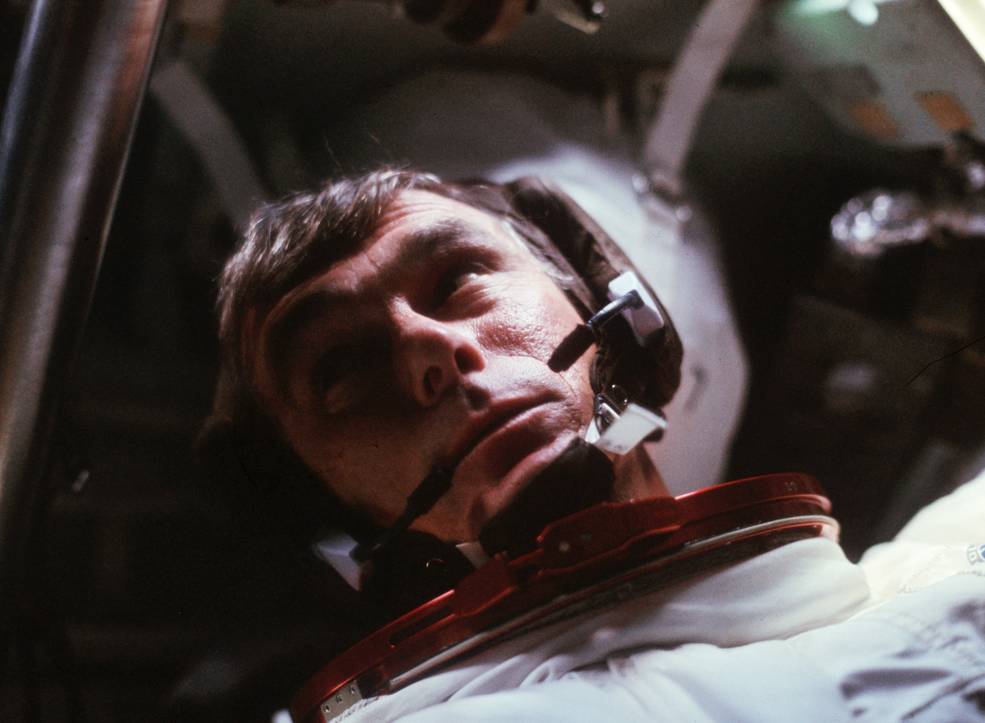
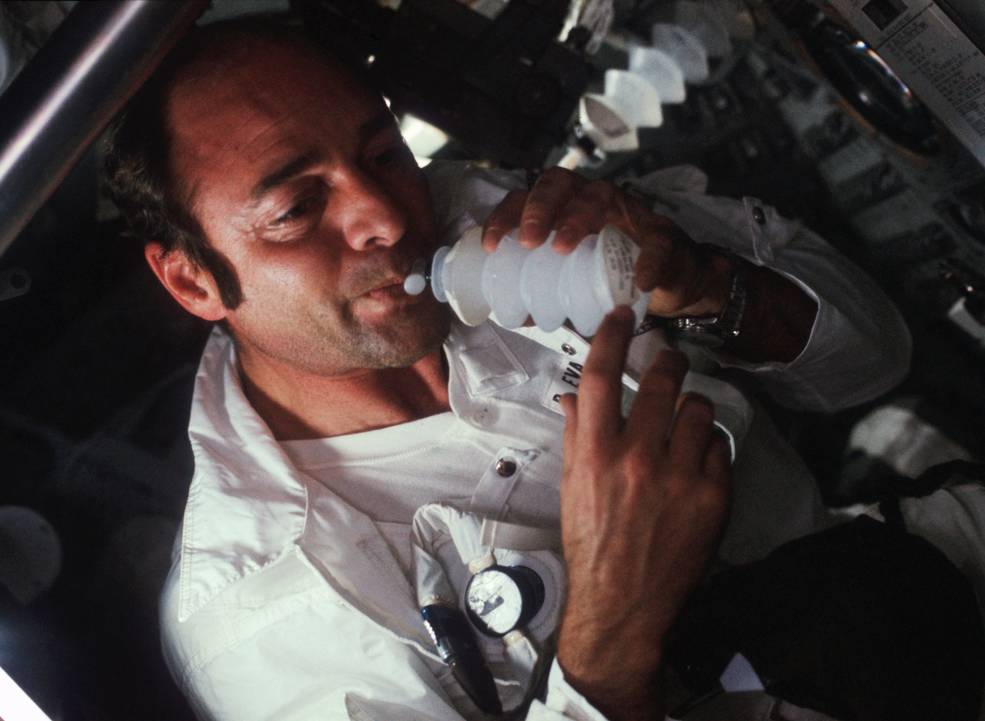
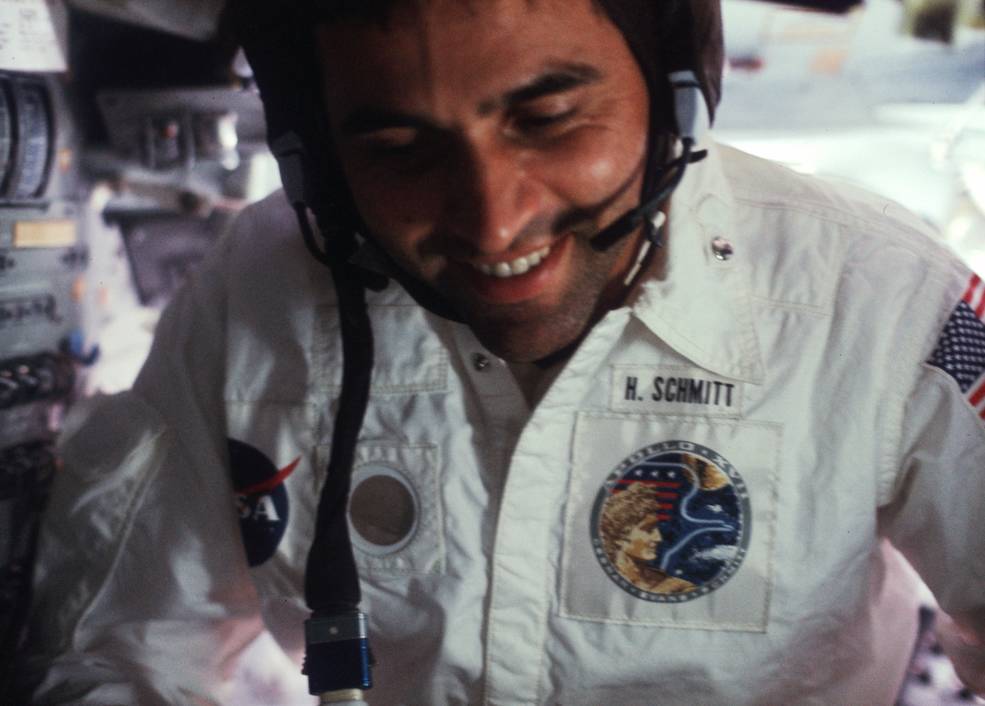
The Apollo 17 astronauts during the trans-lunar coast: Eugene A. Cernan, left, Ronald E. Evans – testing out a beverage container planned for the Skylab program, – and Harrison H. “Jack” Schmitt.
While the crew slept aboard their spacecraft America, in Mission Control, Flight Director Gerald D. “Gerry” Griffin and his Gold Team of controllers took over the consoles from Frank’s Orange Team, with Parker remaining at the capcom position until he placed the wake-up call to the crew. At that point, Apollo 17 had reached a distance of 77,500 miles from Earth. Astronaut C. Gordon Fullerton took over the capcom console for the crew’s morning activities, assisted by astronaut Stuart A. Roosa, and Kranz’s White Team came in to relieve Griffin’s Gold Team. The astronauts spent much of the day, shortened to synchronize the crew’s day with Houston time, completing housekeeping and navigation tasks aboard their spacecraft, and provided to the ground their impressions of the previous day’s launch and TLI. Schmitt spent much of the day providing commentary on his views of the Earth. Before going to sleep, the astronauts re-established the PTC mode, while in Mission Control, Flight Director Frank’s Orange Team resumed their console positions, with Overmyer returning as capcom. When Cernan said good night on the crew’s behalf, Apollo 17 had reached a distance of 115,000 miles from Earth.
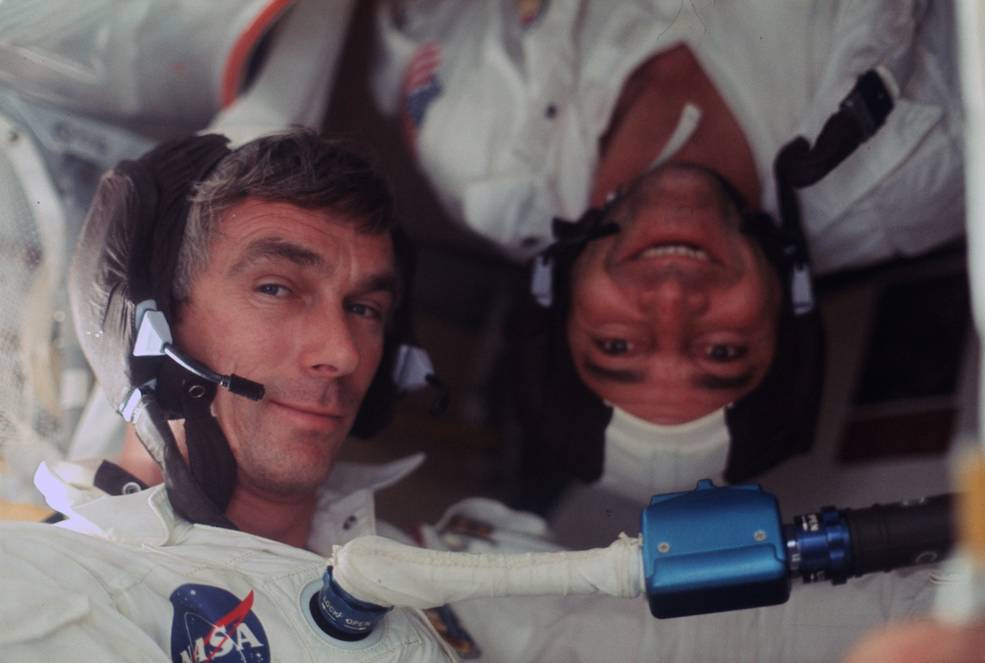
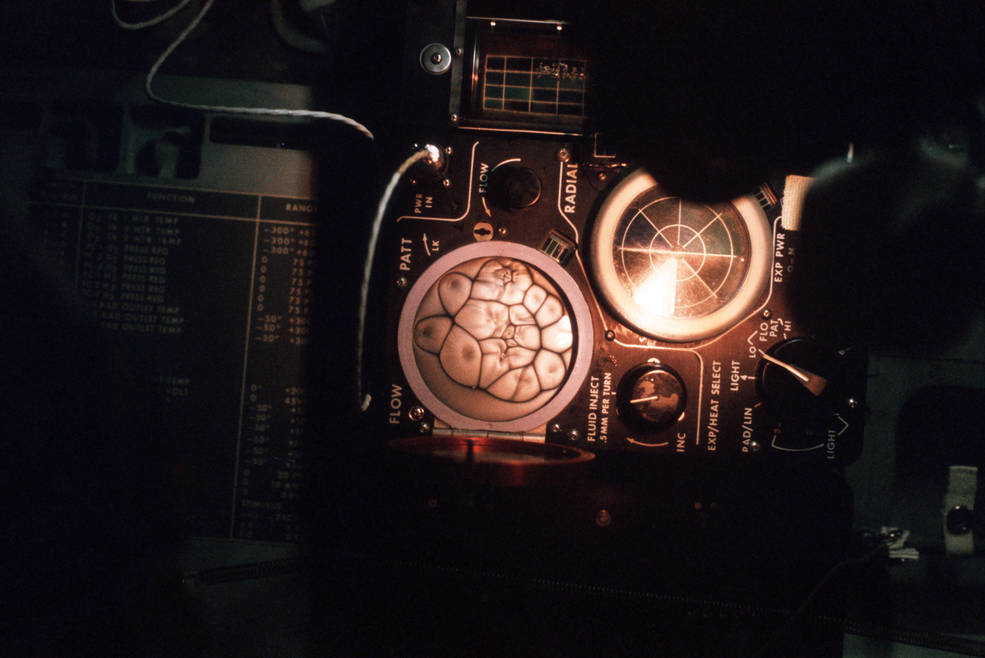
Left: Apollo 17 astronauts Eugene A. Cernan, left, and Ronald E. Evans during the trans-lunar coast. Right: The Heat Flow and Convection demonstration experiment.
While the crew slept, Apollo 17 reached the halfway point with respect to distance between the Earth and the Moon, an equidistant 132,123 miles. In Mission Control, Parker returned as capcom, and Flight Director Griffin’s Gold Team resumed their console positions. When Parker called to awaken the crew, Apollo 17 had traveled more than 140,000 miles from Earth. With that task completed, he handed over capcom duties to Fullerton. One of the first tasks of the day involved a midcourse correction, a two-second burn of the Service Propulsion System (SPS) engine that adjusted their trajectory to take them within 60 miles of the Moon for the Lunar Orbit Insertion burn. The crew moved on to the next major task of the day, opening the hatches to enter the LM Challenger for the first time. During this initial inspection, Cernan and Schmitt transferred some items from the CM America and arranged stowage inside the LM. As Cernan and Schmitt completed their activities in Challenger and returned to America, in Mission Control Overmyer replaced Fullerton as capcom, and new Flight Director Charles R. “Chuck” Lewis took over, leading the Orange Team, until Flight Director Kranz’s team once again took their consoles. Evans conducted the heat flow and convection experiment, a demonstration designed to provide data on the behavior of fluids in the microgravity environment. By the time the crew retired, they had begun closing in on the Moon, now only 88,000 miles away.
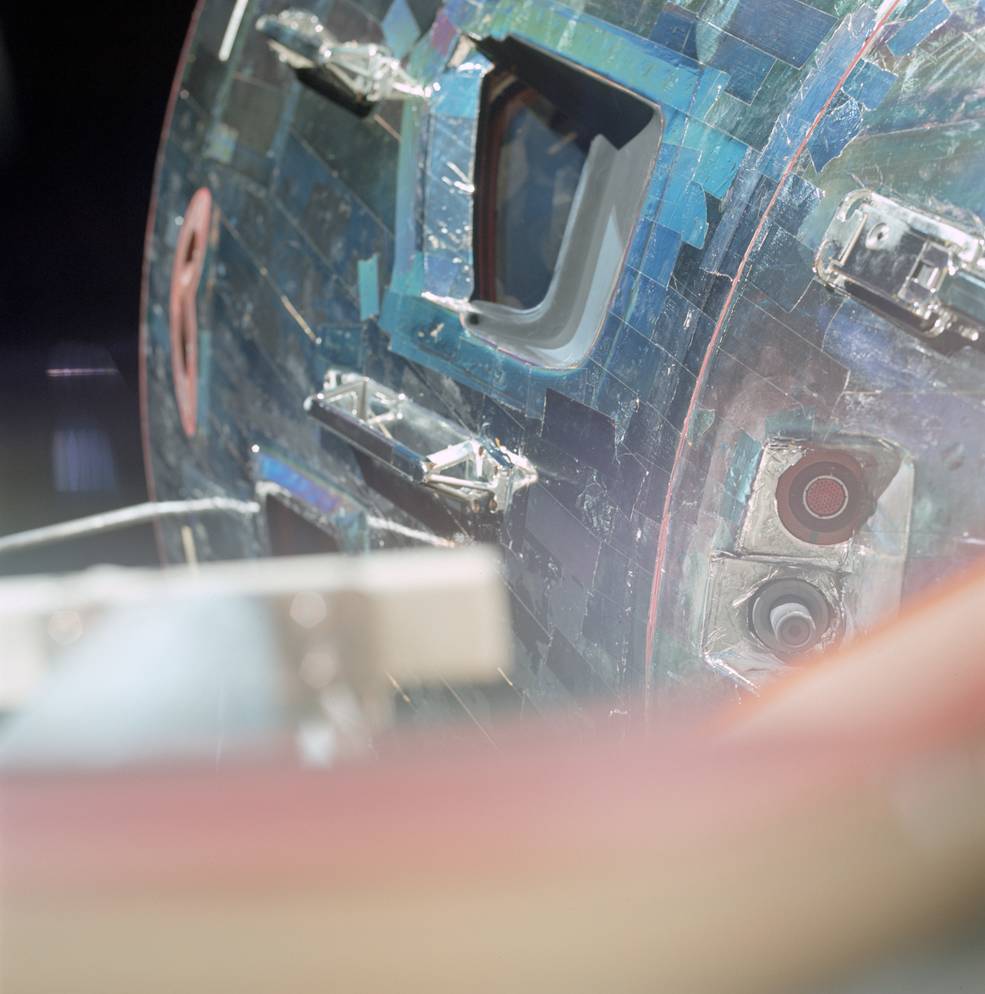

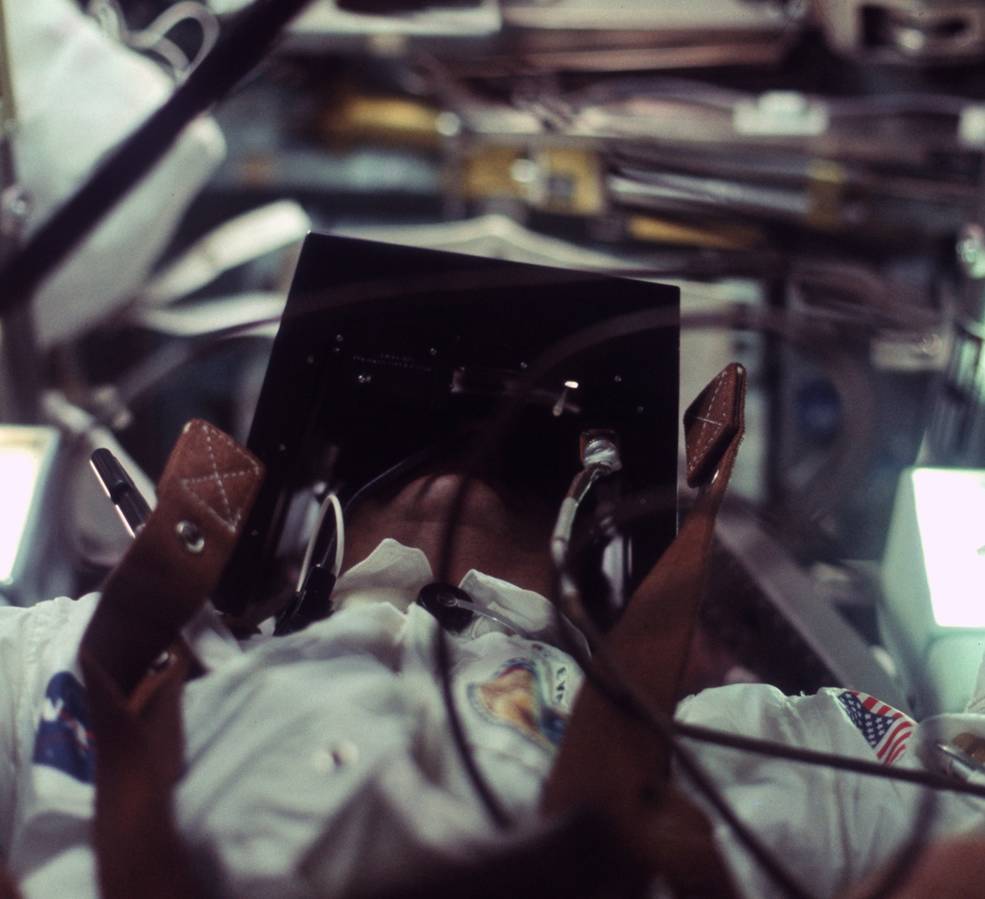
Left and middle: Two views of the Command Module America taken from the overhead window of the Lunar Module Challenger. Right: Evans conducting a session of the Apollo Light Flash Moving Emulsion Detector (ALFMED) experiment.
While the crew slept, in Mission Control, new Flight Director Neil A. Hutchinson and his team took over from Kranz’s team, with Fullerton once again acting as capcom. Mission Control awakened the crew with the University of Kansas Jayhawk Fight Song, in honor of Evans’ alma mater. Apollo 17 had traveled 196,400 miles from Earth, closing in on the Moon, 72,000 miles away. Cernan and Schmitt reentered the LM Challenger for a more thorough activation and checkout, and Evans also briefly transferred over to take some photographs of the CM from the LM’s overhead window. At 65 hours into the flight, Mission Control adjusted all the clocks ahead by 2 hours and 40 minutes to account for the launch delay, ensuring that the flight plan would not require any adjustments once the spacecraft entered lunar orbit the next day. Evans conducted the Apollo Light Flash Moving Emulsion Detector (ALFMED) experiment, while Cernan and Schmitt wore eyeshades, to monitor light flashes caused by cosmic rays passing through their retinas. They caught sight of the S-IVB in the distance, flashing periodically as it tumbled on its way to impact the Moon. At 73 hours and 17 minutes into the flight and still 38, 900 miles from the Moon, Apollo 17 transitioned from the Earth’s gravity sphere of influence to the Moon’s and began to accelerate. Shortly thereafter, the crew began their sleep period.
Capcom Parker awakened the crew for its fourth day in space. He informed the astronauts that since their trajectory continued to be very accurate, they would not have to execute a midcourse correction maneuver planned for the day. They maneuvered their spacecraft into the proper attitude and jettisoned the panel the covered the Scientific Instrument Module (SIM) bay of the Service Module, exposing the cameras and instruments that Evans will use once in lunar orbit. For the first time during the flight, the astronauts caught sight of the Moon, appearing as a very thin crescent, with most of its surface in darkness and the bright Sun appearing to hang on the Moon’s horizon. Shortly before disappearing behind the Moon, Cernan congratulated the Mission Control team regarding the accuracy of their trajectory, “If you guys could get an idea down there of the needle you’re threading when you shoot for 50 miles at a quarter of [a] million [miles], you’d be mighty proud of yourselves, I’ll tell you, we are.” Evans maneuvered the spacecraft into the proper attitude for the Lunar Orbit Insertion burn, and precisely 88 hours and 43 minutes after leaving Earth Apollo 17 disappeared behind the leading edge of the Moon, all communications with Mission Control stopping as expected. While behind the Moon, Apollo 17 fired its SPS engine for 6 minutes and 33 seconds to enter an initial elliptical lunar orbit.
To be continued…
John Uri
NASA Johnson Space Center


























